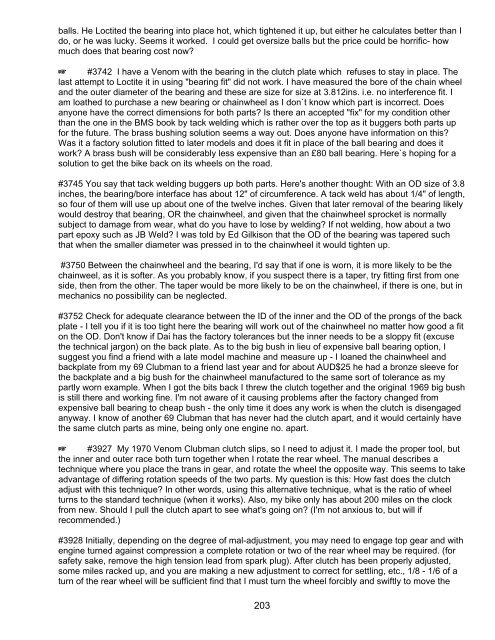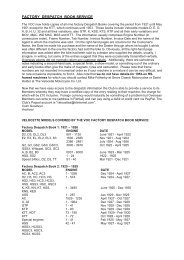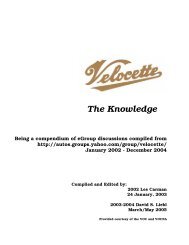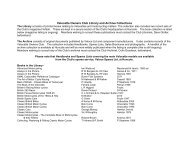The Knowledge - Velocette Owners Club
The Knowledge - Velocette Owners Club
The Knowledge - Velocette Owners Club
You also want an ePaper? Increase the reach of your titles
YUMPU automatically turns print PDFs into web optimized ePapers that Google loves.
alls. He Loctited the bearing into place hot, which tightened it up, but either he calculates better than I<br />
do, or he was lucky. Seems it worked. I could get oversize balls but the price could be horrific- how<br />
much does that bearing cost now?<br />
L #3742 I have a Venom with the bearing in the clutch plate which refuses to stay in place. <strong>The</strong><br />
last attempt to Loctite it in using "bearing fit" did not work. I have measured the bore of the chain wheel<br />
and the outer diameter of the bearing and these are size for size at 3.812ins. i.e. no interference fit. I<br />
am loathed to purchase a new bearing or chainwheel as I don`t know which part is incorrect. Does<br />
anyone have the correct dimensions for both parts? Is there an accepted "fix" for my condition other<br />
than the one in the BMS book by tack welding which is rather over the top as it buggers both parts up<br />
for the future. <strong>The</strong> brass bushing solution seems a way out. Does anyone have information on this?<br />
Was it a factory solution fitted to later models and does it fit in place of the ball bearing and does it<br />
work? A brass bush will be considerably less expensive than an £80 ball bearing. Here`s hoping for a<br />
solution to get the bike back on its wheels on the road.<br />
#3745 You say that tack welding buggers up both parts. Here's another thought: With an OD size of 3.8<br />
inches, the bearing/bore interface has about 12" of circumference. A tack weld has about 1/4" of length,<br />
so four of them will use up about one of the twelve inches. Given that later removal of the bearing likely<br />
would destroy that bearing, OR the chainwheel, and given that the chainwheel sprocket is normally<br />
subject to damage from wear, what do you have to lose by welding? If not welding, how about a two<br />
part epoxy such as JB Weld? I was told by Ed Gilkison that the OD of the bearing was tapered such<br />
that when the smaller diameter was pressed in to the chainwheel it would tighten up.<br />
#3750 Between the chainwheel and the bearing, I'd say that if one is worn, it is more likely to be the<br />
chainweel, as it is softer. As you probably know, if you suspect there is a taper, try fitting first from one<br />
side, then from the other. <strong>The</strong> taper would be more likely to be on the chainwheel, if there is one, but in<br />
mechanics no possibility can be neglected.<br />
#3752 Check for adequate clearance between the ID of the inner and the OD of the prongs of the back<br />
plate - I tell you if it is too tight here the bearing will work out of the chainwheel no matter how good a fit<br />
on the OD. Don't know if Dai has the factory tolerances but the inner needs to be a sloppy fit (excuse<br />
the technical jargon) on the back plate. As to the big bush in lieu of expensive ball bearing option, I<br />
suggest you find a friend with a late model machine and measure up - I loaned the chainwheel and<br />
backplate from my 69 <strong>Club</strong>man to a friend last year and for about AUD$25 he had a bronze sleeve for<br />
the backplate and a big bush for the chainwheel manufactured to the same sort of tolerance as my<br />
partly worn example. When I got the bits back I threw the clutch together and the original 1969 big bush<br />
is still there and working fine. I'm not aware of it causing problems after the factory changed from<br />
expensive ball bearing to cheap bush - the only time it does any work is when the clutch is disengaged<br />
anyway. I know of another 69 <strong>Club</strong>man that has never had the clutch apart, and it would certainly have<br />
the same clutch parts as mine, being only one engine no. apart.<br />
L #3927 My 1970 Venom <strong>Club</strong>man clutch slips, so I need to adjust it. I made the proper tool, but<br />
the inner and outer race both turn together when I rotate the rear wheel. <strong>The</strong> manual describes a<br />
technique where you place the trans in gear, and rotate the wheel the opposite way. This seems to take<br />
advantage of differing rotation speeds of the two parts. My question is this: How fast does the clutch<br />
adjust with this technique? In other words, using this alternative technique, what is the ratio of wheel<br />
turns to the standard technique (when it works). Also, my bike only has about 200 miles on the clock<br />
from new. Should I pull the clutch apart to see what's going on? (I'm not anxious to, but will if<br />
recommended.)<br />
#3928 Initially, depending on the degree of mal-adjustment, you may need to engage top gear and with<br />
engine turned against compression a complete rotation or two of the rear wheel may be required. (for<br />
safety sake, remove the high tension lead from spark plug). After clutch has been properly adjusted,<br />
some miles racked up, and you are making a new adjustment to correct for settling, etc., 1/8 - 1/6 of a<br />
turn of the rear wheel will be sufficient find that I must turn the wheel forcibly and swiftly to move the<br />
203





